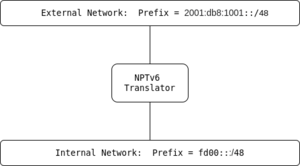| Communication protocol | |
 | |
| Purpose | network address translation |
|---|---|
| Introduction | 2011; 14 years ago (2011) |
| RFC(s) | 6296, 7157... |
IPv6-to-IPv6 Network Prefix Translation (NPTv6) is a specification for IPv6 to achieve address-independence at the network edge, similar to network address translation (NAT) in Internet Protocol version 4 (IPv4). It has fewer architectural problems than traditional IPv4 NAT; for example, it is stateless and preserves the reachability attributed to the end-to-end principle. However, the method may not translate embedded IPv6 addresses properly (IPsec can be impacted), and split-horizon DNS may be required for use in a business environment.

NPTv6 differs from NAT66, which is stateful. With NPTv6, no port translation is required nor other manipulation of transport characteristics. Compared to NAT66, with NPTv6 there is end-to-end reachability along with 1:1 address mapping. This makes NPTv6 a better choice than NAT66.
References
- "3 Ways to Ruin Your Future Network with IPv6 Unique Local Addresses (Part 1 of 2)". Infoblox Blog. 2016-02-27. Retrieved 2021-12-24.
External links
- Cisco documentation on NPTv6
- Juniper documentation on NPTv6
- VyOS documentation on NPTv6
- OPNsense documentation on NPTv6
- APNIC blog post from 2018 on NAT66
- pfSense documentation on NPt
This computer networking article is a stub. You can help Misplaced Pages by expanding it. |